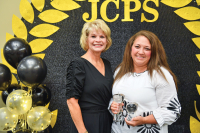Citizen scientists help PARI catalog celestial photographs
 The Pisgah Astronomical Research Institute is making use of citizen scientists from around the world to help sort and catalog its photo albums of the universe.
The Pisgah Astronomical Research Institute is making use of citizen scientists from around the world to help sort and catalog its photo albums of the universe.
Since the late 1800s, astronomers have been taking images of the night sky, using the telescope like a long camera lens and putting either film or small, photographic plates at the eyepiece.
Oftentimes scientists placed a prism at the front of the telescope to refract light from the myriad stars into spectra. So, instead of bright points of light on a dark background, as one would envision a picture of the universe, the photograph looks more like a night sky filled with dozens of tiny barcodes of light.
Like a celestial fingerprint, each star’s light spectrum holds invaluable data about the star — clues about its age, brightness, temperature and more.
“You get all types of good information,” said Michael Castelaz, PARI’s science director.
Related Items
As astronomers went digital with their photography in the 1990s, collections of star plates have ceased to grow. And, universities and observatories across the globe, through years of accumulating plates of the universe, are faced with the dilemma of where to store them.
PARI, with multiple buildings scattered across 200 acres in the Pisgah National Forest, has plenty of space to hold old photography collections.
The first collection the institute agreed to take on was from a University of Michigan researcher, Nancy Houk, who retired and was politely asked to give up her spacious workspace for a smaller office reserved for professor emeritus. She was at a loss as to what she would do with the plates accumulated over years of research, until she got a hold of PARI and its staff made the trip to Michigan.
“We went up there with a U-Haul truck and found her,” Castelaz said. “She had all of her plates stacked up in boxes outside of her new office.”
PARI took 3,000 six-inch-by-six-inch plates off Houk’s hands. She had been taking photos of the universe since she began studying astronomy in the early 1960s, but had only managed to classify 180,000 stars. Between 200,000 and 300,000 remained. The spectra of light captured on each plate allows scientists to catalog stars in seven different main categories and about a handful of sub-categories based on size, brightness and other characteristics.
After taking over the collection, Castelaz was determined to categorize the uncategorized stars. But reality soon set it.
“About an hour later, I said to myself ‘this is nuts because there’s no way I’m going to go through 3,000 plates and look at the stars from 3,000 plates,’” Castelaz said. “That’s nuts, nobody will ever do that job.”
To make the task even more daunting, since that first set of plates was brought to PARI in 2004, the site has amassed more than 40 collections containing more than 220,000 plates, with some photos dating back to 1898. With the likes of the Yerkes Observatory at the University of Chicago and the Harvard College Observatory, PARI has become one of the go-to repositories for historic photographs of the universe.
“People began to realize this might be a home for photographic plates,” Castelaz said. “Now, we have all these collections of plates.”
Yet, the task that PARI faced was how to take the information on the plates and make it available to researchers in Russia to California. To do that, the old plates need to be digitized. And the data of the stars needs to be classified and organized.
PARI’s solution was to create the citizen science project SCOPE: Stellar Classification Online Public Exploration. PARI staff has scanned and uploaded thousands of the plates and star spectra online to a website. There, willing volunteers can access them and sort through the images, following PARI’s instructions to classify stars.
The only way to classify decades of history of hundreds of thousands of stars was to employ the help of as many people as Castelaz could. Once accessible to researchers, the data will inevitably contribute to advances in the field.
“There are 220,000 plates — there will be eureka moments. We just haven’t had them yet,” Castelaz said. “It just takes time and people power.”
Though advances in technology have made plate photography essentially obsolete, what makes them valuable to science is when they were taken. Apart from the historic imagery, astronomers have few options for tracking changes in the universe.
Over the span of a century or half-century, a star may have gone nova, expanded, contracted or gone binary, Castelaz said. Examining modern images would lend limited insight into a star’s past.
Also, each photographic plate contains information on the earth’s atmosphere, which might be useful to a climatologist. Or a historian might be interested in plates with historical or social significance.
“Today is not 1965 or 1970 — the sky changes,” Castelaz said. Studying the old photographs is a field called time-domain photography. “We’re time travelers.”
But progress for SCOPE is still slow to get a grasp on the massive amounts of star data at PARI. With 1,800 citizen scientists participating around the globe, Castelaz likes that the project allows everyday people to get hands on with astronomy.
However, he understands its limitations as well. Only about 5 percent of the plates have been uploaded onto the website and countless stars sit collecting dust and waiting for a classification. Which is why the institute is enlisting the help of a programming specialist to make the star classification more automated.
Currently, a star needs to be classified by a dozen or so volunteers before PARI takes the average classification and officially documents the star.
However, doing away entirely the human component is not something Castelaz has in mind.
“We don’t want to hide this data,” he said. “We want people to see what astronomers actually do — if we were to computerize it all it would be done and no big deal.”
Want to go?
The Pisgah Astronomical Research Institute is holding a night sky presentation at 7 p.m. Friday, Sept. 13, at their campus in the Pisgah National Forest.
The evening’s activities will include a tour of the PARI facilities, a presentation in the PARI StarLab planetarium and, weather permitting, celestial observations using PARI’s telescopes.
The program is part of PARI’s monthly Evening at PARI series and will feature presentations by PARI astronomers. Reservations are required and will be accepted until 3 p.m. the day of the event. $20 per adult, $15 for seniors and military and $10 for children under 14.
www.pari.edu or 828.862.5554.









